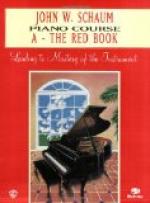“Soon after this incident, I was taken to the Professor’s studio. He examined me, considered I had talent, and thought it should be cultivated. So he took me in hand. I was then five, and my real musical education began at that time.
“From the very first I adopted a position of hand which seemed to me most convenient and comfortable, and no amount of contrary instruction and advice has ever been able to make me change it. I play scales and passages with low hand and flat fingers because that position seems the most favorable for my hand. When practising, I play everything very slowly, raising my fingers high and straight from the knuckle joint. This gives me great clearness and firmness. In rapid passage work the action is reduced, but the position remains. I am said to have a clear, pearly touch, with quite sufficient power at my command for large works.
“After five years of study with my first teacher, Rudolph Heim, a pupil of Moscheles, I entered the Moscow Conservatory, and continued my studies under Professor Pabst, brother and teacher of the composer of that name. I was then ten years old. Professor Pabst was very conservative, very strict, and kept me at work on the music of the older masters. This kind of music suits me, I think; at least I enjoy it. Even here I still clung to my ideas of holding my hands and of touching the keys, and always expect to do so.
“I remained with this professor about six years and then began my public career.
“You ask about my present studies, and how I regulate my practise. During my periods of rest from concert work, I practise a great deal—I wish I could say all the time, but that is not quite possible. I give an hour or more a day to technical practise. As to the material, I use Chopin’s Etudes constantly, playing them with high-raised, outstretched fingers, in very slow tempo. One finds almost every technical problem illustrated in these etudes; octaves, arpeggios, scales in double thirds and sixths, repeated notes, as in number 7, broken chords and passage work. I keep all these etudes in daily practise, also using some of the Liszt Etudes Transcendantes, and, of course, Bach. The advantage of using this sort of material is that one never tires of it; it is always interesting and beautiful. With this material well in hand, I am always ready for recital, and need only to add special pieces and modern music.
“In learning a new work I first study it very slowly, trying to become familiar with its meaning. I form my concept of it and live with it for months before I care to bring it forward. I try to form an ideal conception of the piece, work this out in every detail, then always endeavor to render it as closely like the ideal as possible.”
VII
ETHEL LEGINSKA




